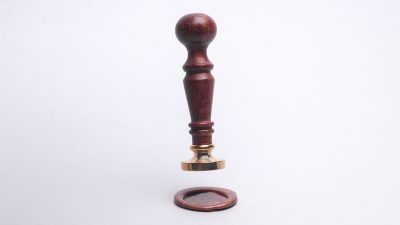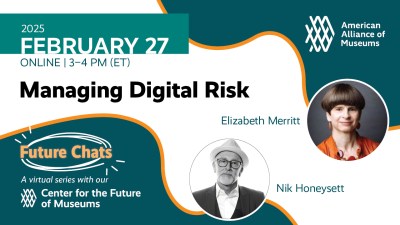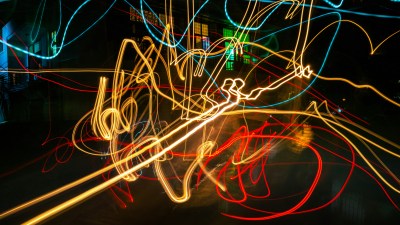
Introduction to This Scenario
“Our Bright Future” is a story based on the hopes and aspirations that museum people shared with AAM’s Center for the Future of Museums when we asked, “What is the best future you can imagine?” While it is unlikely that all these happy dreams will combine to form one blindingly bright future, they all fall somewhere in the range of plausibility. (See Signals, below, for current trends and events that support that case.)
Picturing a best-case scenario is not just an exercise in wishful thinking. Exploring optimistic outcomes helps organizations test their assumptions, build alignment among stakeholders, and identify actions that can turn vision into reality. Imagining the best future can help members of the museums leadership and key stakeholders:
- Compare their individual hopes for the future and arrive at an organizational consensus about aspirational goals for the community and the museum. One person’s version of success (booming local development, rising property values, expansion of the museum’s footprint and staff) might strike someone else as a nightmare scenario that paves the way for gentrification, displacement, and loss of the organization’s core identity.
- In the process, take a critical look at what they think they want. People are actually very bad at anticipating what will make them happy. Achieving long-desired goals such as getting tenure or a raise, or buying a house, often leaves a person’s baseline happiness unchanged. Similarly, organizations sometimes make unquestioned assumptions about success. Are more visitors, bigger collections, or a new building the best way to fulfill your mission?
- Prepare for the best. On a personal scale, happy life events like marriage, the arrival of a baby, moving, and taking a new job can be pretty traumatic. The same holds true for organizations. Many highly anticipated events in the life cycle of a museum—a successful capital campaign, expansion of staff, opening of a new wing—come with challenges that can derail previously successful organizations. By asking “And then what?” about elements in your best‑case scenario, your museum can prepare to respond to the opportunities afforded by these events if they become reality.
- Challenge your planning team to explore “How could we help this come true?” As you write your organizational plan, you can allocate time and resources to incremental steps that will take you in the right direction. This exercise can also prepare you to recognize and take advantage of serendipitous opportunities that a narrow focus on “the plan” might otherwise lead you to ignore.
A Snapshot of This Future
This synopsis describes a vision of the year 2040 with respect to culture, technology, the economy, ecology, and policy.
America in 2040 is more tolerant, less divisive, and more socially and economically equitable than it was early in the century. The civil rights activism of the 2010s paved the way for major investments by government, philanthropy, and big business in efforts to eliminate racial disparities in health, education, incarceration, and employment. Mounting evidence of the broad economic benefits of dismantling systemic equities laid the foundation for bipartisan political support of these goals. Younger Americans, born into a majority-minority age cohort, take diversity and multiculturalism for granted. A large segment of the population is over the age of 65 (20 percent in 2040, compared to 16 percent in 2020), and these “perennials” are heavily dependent on first-generation immigrants for home care and personal assistance. The ubiquity of these arrangements, with the social bonds and intercultural exposure they afford, has led to a significant rise in tolerance and reduction in bias among older Americans.
Automation, fueled by robotics and artificial intelligence (AI), has increased productivity and profits for many industries, including domestic manufacturing, e-commerce, data services, and health care. As was predicted at the turn of the century, this AI revolution has caused massive disruptions to many professions, from white-collar bastions such as law and medicine to blue-collar stalwarts like telemarketing and long-haul trucking. While the immense profits generated by AI have gone disproportionately to the top 1 percent of individuals and companies, government and private philanthropy have channeled much of that wealth back into public infrastructure and the creation of a strong public safety net in the interest of economic and social stability. Universal basic income (UBI) provides an unconditional stipend sufficient to meet every individual’s basic needs. Universal health care (UHC) covers drug rehabilitation, mental health services, and comprehensive support for people with disabilities. Taken together, UBI and UHC have resulted in the flowering of private enterprise, small businesses, and creative endeavors. While there is still great wealth inequality in the US, these opportunities have built a new, robust “middle class” with the assets it needs for self-fulfillment and civic participation.
The promise of AI and big data has come to fruition in the past two decades largely because companies and regulatory agencies worked together to address valid public concerns about privacy and surveillance. The public played a direct role in “leashing the data beast” by becoming highly selective about what online services they used, what terms they agreed to, and how they controlled their own personal data. Revenue models based on harvesting and selling personal data have been largely discredited, and social media has fragmented into a plethora of platforms, some of them supported by subscription while others, modeled on Wikipedia, are open-source, community-run, and donation-supported. The Algorithmic Transparency Act of 2025 helped minimize bias in the AI programs that have become essential to our educational systems, law enforcement, and job recruitment and hiring.
Strong privacy protection also helped fuel development of the huge, open, interoperable data sets that are shared among sectors (health, government, education). These data sets in turn enabled researchers to conduct large-scale longitudinal studies that established the benefits of a variety of types of behavior, including cultural engagement. This research played a majorrole in the resurgence of government funding for the arts and humanities, as advocates made the case that such support not only achieved an intrinsic good, but made financial sense. As Sriram Mather, Republican senator from Utah and chair of the Senate Finance Committee, remarked when explaining his support for doubling the funding for the National Endowment for the Arts in 2032, “If the arts can help keep at-risk teens in school and out of jail, I’m all for it. I’d rather build museums than prisons.”
Primary education has slowly pivoted away from “industrialized” learning, standardized tests, and age-based classrooms. Indeed, it has largely broken out of the four walls of the traditional school building and now takes place in many locations, public and private, throughout the community. The new model of education emphasizes creativity, collaboration, social intelligence,
and cross-disciplinary thinking. The mainstream approach is experiential and inquiry-based. Students work with mentors to create and execute personalized learning plans that build on their passions and learning styles. Two-thirds of states have adopted pooled funding for public schools (first implemented by Vermont in 1997), sharing wealth among districts and reducing inequalities of education and opportunity. A huge endowment created by tech billionaires Elon Musk, Peter Thiel, and Pierre Omidyar in 2025 ensures that every child is provided with an AI-enabled tutor that provides personalized content and connections to suitable online and community-based learning opportunities. Higher education has diversified into a robust set of effective, affordable options that include community colleges, microcredentialing, apprenticeship programs, and online courses. Regulatory reform has lifted the burden of crippling student debt. Many students take advantage of income-sharing agreements that offer low-cost tuition and loans in exchange for a share of future earnings.
Multisensory, immersive augmented reality (AR) and virtual reality (VR) tech is affordable and widely used in education, medicine, workplace applications, and popular entertainment. However, while these technologies are deeply integrated into everyday living, public preference for leisure time has shifted to real-life, face-to-face social interaction, and to place-based
immersive experiences that may or may not incorporate digital elements. Although 80 percent of adults access VR at least once a day, “digital fasting” has become increasingly popular, and many adults, especially parents, regularly take themselves and their families off-line for anywhere from a day to a week at a time.
The year 2021, now known as “Anthrogeddon,” marked a turning point in the US’s stance on climate change. That summer, every state capital experienced record-high temperatures; 12 large-scale natural disasters (flood, fire, storm, drought) fueled by climate change displaced over 1 million people from their homes; and five major coastal cities suffered destructive flooding. In the aftermath of this trauma, a national carbon tax was instituted with bipartisan backing, and the US threw its considerable resources into support of the Paris Climate Accords. The subsequent global partnership among governments and NGOs has been characterized as an effort on par with the united efforts of the Allied forces during World War Two. The world economy has been converted to a low-carbon energy system, and as a result, the earth is on track to meet the more ambitious goal of the accords, limiting the temperature increase to 1.5 degrees Celsius above pre-industrial levels by mid-century. These initiatives have reduced global sea level rise to just under 3/4 foot (23 centimeters)—at the low end of the most optimistic projections made in 2018.
Signals
A selection of real news stories and research from the present illustrating trends and events that could create this version of the future.
On the case for bipartisan support for social justice and universal basic income
The W. K. Kellogg Foundation released The Business Case for Racial Equity: a strategy for growth (2018), arguing that the US could realize an $8 trillion gain in gross domestic product (GDP) by closing the racial equity gap. (For scale, in 2016 the entire US GDP was $18.57 billion.) A study by the Roosevelt Institute concluded that an annual universal basic income of $12,000 per adult would grow the economy by more than 12 percent over eight years, increasing the GDP by $2.48 trillion. A Gallup poll showed that almost half of Americans support a UBI program, up from 12 percent in 2008. Numerous tests of UBI are in process across the globe, including trials in Oakland and Stockton, California.
On the rise of data privacy
Facebook founder Mark Zuckerberg was called to testify in 2018 before Senate and House committees regarding his company’s decision to allow research firm Cambridge Analytica to access the personal data of as many as 87 million users. The European Union’s sweeping new privacy law went into effect in May, and because the General Data Protection Regulation applies to any business that holds data on EU citizens, it is having a worldwide impact. Similarly, California is poised to vote on a ballot initiative that would enact one of the broadest privacy laws in the US. If the act passes, many companies may voluntarily adopt the same standards on a national level. Concerns about the data practices of large social media platforms have fueled interest in alternatives such as MeWe, which “challenges the status quo by making privacy the foundation of online social experiences”; the opensource project Diaspora; Steemit and Minds, both of which reward contributors and community curators with cryptocurrency; and Ello, created and maintained by a global community of artists.
On the potential for a global commitment to a carbon-neutral power supply
In 2017, the Climate Leadership Council, comprised of Republican elder statesmen, unveiled a “conservative climate solution” that would fight global warming by taxing greenhouse gas emissions and returning the money to taxpayers as a “climate dividend.” Their premise is that increasing the cost of making energy derived from fossil fuels will impel the free market to pivot towards renewable energy and other low-carbon solutions. Exxon Mobil, other oil companies, and a number of major corporations joined the Nature Conservancy and the World Resources Institute in backing the proposal.. The European Union (EU) is already planning to generate 20 percent of its electricity using only renewable sources by 2020. One of the major pressures driving the adoption of renewables is Europe’s annual $38 billion carbon market. On
Discussion Guide
Reality Check
Despite the signals listed above, you may feel that some of the elements in this story are implausible. If so, see if you can find recent stories or research that bolster your case for pushing these plot lines back into the “Cone of Plausibility.”
Agree/Disagree
You may love some parts of “Our Bright Future,” and you may feel that certain elements of this scenario, as written, aren’t desirable. That’s great! Disagreement can spark discussion about values and surface differences of opinion. Use this story as a starting point and edit, adapt, and develop it to reflect your shared version of a bright future.
Museums in This Future
What are some of the implications of this future for museums? Here are a few thoughts to get you started:
- The nurturing environment of this bright future leads to a boom in new cultural nonprofits. While funding is abundant, this proliferation leads to increased competition for time and attention, as well as philanthropic and government funding.
- With the security provided by UBI and UHC, many people are pursuing their passions as full- or part-time citizen artists, citizen scientists, and citizen historians. These communities expect museum resources to be open and accessible and want to play significant roles in museum research and content creation.
- Creators of VR and AR content see museums as premiere sources of high-quality digital content. At the same time, museums are popular destinations for those looking to unplug from the digital world.
From Insight to Foresight
Exploring scenarios helps us future-proof plans by asking, “How, in this future, would I/my family/my community/my museum thrive?” By answering this question across several scenarios, you may identify actions that would be beneficial in a variety of circumstances.
In this future I might:
In this future my organization might:
From Foresight to Action
This story is built around trends and events we can see in the world today. But always remember the third force creating the future: the choices that we make as individuals and as organizations. The most important part of this exercise is discovering how you can help build the future you want to live. After you’ve tweaked this scenario to reflect a future you agree is both plausible and preferable, work on the following questions.
To help create this future I might:
To help create this future my organization might:









Thanks to Elizabeth Merritt and her associates for their work, and for inviting comments.
Instead of tweaking the “Our Bright Future” scenario, let’s accept it but elaborate upon it: show details and linkages more precisely, to help museums answer “and then what?” questions.
For example, an “and then what?” question is: if we have UBI, UHC, and spending on low-carbon infrastructure, will higher taxes for those items then crowd out tax support for museums? (Some estimates for UBI set new taxes at 3 trillion dollars, though that might be less if Social Security, Medicare, Medicaid, and Pell grants were abolished). In the last decade, various states cut museum budgets to direct revenues to other priorities. If low-carbon infrastructure spending were “on par with the united efforts of the Allied forces during World War Two,” wouldn’t then museum spending be on a par with museum spending then, rather low?
As to the claim that with UBI “many people are pursuing their passions as full- or part-time citizen artists, citizen scientists, and citizen historians,” proponents of UBI often suggest an annual payment of $12,000. For factory workers and truck drivers now earning $50,000, that’s a drop of about 75%, which actually happened to many factory workers in the last 20 years of globalization and recession as they were forced to take part-time jobs at Walmart. Is there evidence that many of those workers displaced in the last 20 years became citizen artists?
In short, the scenarios would be even more helpful to practitioners if they described details and linkages more concretely, and cited more aggregate data from recent years.
I feel that is one of the most important info for me.
And i am satisfied studying your article. But should
statement on few general things, The web site style is perfect, the articles
is really excellent : D. Excellent job, cheers
Hello superb blog! Does running a blog such as this take a
lot of work? I have virtually no expertise in coding
but I had been hoping to start my own blog in the near future.
Anyways, should you have any recommendations or tips for new blog owners please share.
I know this is off subject but I just needed to ask. Many thanks!
Hello,
It does take a lot of coordination with authors to keep getting great content. But, people in the museum field are often more than willing to contribute their great stories for their fellow colleagues in the field.
I hope this helps.